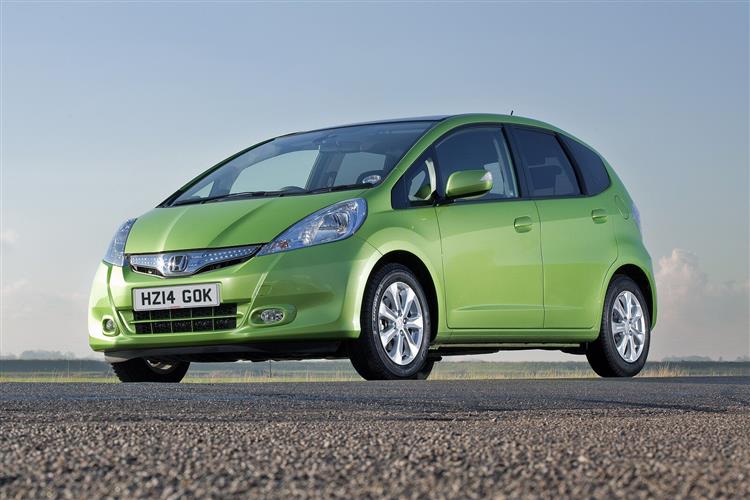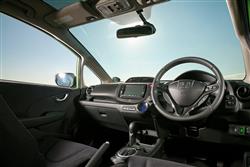This is a sample, showing 30 seconds of each section.
CURRENT AFFAIRS (some text hidden) SECTIONED_new_hondajazzhybrid_2011
By Andy Enright
Introductionword count: 67
The Honda Jazz was the very first hybrid supermini and featured some very clever engineering. Buyers on the used market might worry that this will make it complex and expensive to maintain, but Honda doesn't design its cars like that. Here's what to look for if you'd like a petrol-powered supermini with diesel-style economy that'll won't let you down and is a bit different to the norm.
Modelsword count: 6
5-door supermini [(1.3 petrol/electric hybrid) Hybrid]
Historyword count: 240
The second generation Honda Jazz arrived in 2008, but the major change to this design came at the point of its mid-life facelift in 2011. That's when the Japanese brand introduced the petrol/electric Hybrid version we're going to look at here, well before Toyota came to market with its rival Yaris Hybrid. This technology pushed this Honda's price up of course, but in return, buyers got a higher quality road going experience with a smooth CVT automatic gearbox. Prior to this Jazz model's arrival, hybrid technology had never been seen in really small cars, models which didn't have room for the bulky battery packs and intelligent power units that drive hybrid power. Automotive designers found these easy enough to package into an SUV, or even a Prius-sized family hatch. But in a little supermini? Prior to 2011, the general thinking was that the practical compromises would surely be greater than family buyers could bear, especially in the supermini segment. Honda disagreed. With this Jazz model, the brand claimed to have incorporated a petrol/electric powerplant with virtually no compromise in practicality, something only possible because of the way this second generation Jazz was designed around this engine. So the clever Magic Seating system remained, even if the two-tier boot floor didn't. For hybrid devotees who can't get on with Honda's larger but quirkier Insight, it might well be tempting. This Jazz sold until the third generation version was unveiled in mid-2015.
What You Getword count: 707
Equipping your Jazz with hybrid power will probably demand from you a premium of around £1,500 over what you'd have paid for an equivalent petrol-powered version, so it's fair for customers of this version to want their cars to stand out a little more from humbler models in the range. Honda has obliged in this respect with a package of aesthetic changes that includes a chrome blue finish for the front grille and the surrounds that encircle the projector-style headlamps. There are smarter alloy wheels too, while at the rear, there's more chrome blue around the tail lamps and a chrome finish above the licence plate. All well and good, but it's as a packaging marvel that this car most stands out. The standard MK2 model Jazz was already one of the cleverest superminis of its era in this respect and Honda's engineers worked hard to try and ensure that the hybrid mechanicals could be incorporated here in such a way as not to dilute this model's inherent versatility. They almost managed it. We say 'almost' because the seats-up boot capacity in this car does fall from the 335-litre total you get in the standard petrol model to 300-litres in this one. And Hybrid buyers have to do without the 64-litre under-boot floor that buyers of the ordinary version can use. But perhaps we're being picky. After all, the seats-folded capacity of 883-litres (rising to 1320-litres if you load to the roof) of a Hybrid Jazz is the same as that of any other model in the range, a statistic that's better than that of the apparently larger Insight. And it's way better than the capacity on offer from a Toyota Auris Hybrid, supposedly a larger car. So no, the hybrid powertrain doesn't seriously dent the Jazz packaging brilliance made possible thanks to the way that the designers moved the fuel tank from beneath the rear seats to a position under those at the front. This has made possible this car's famed 'Magic Seating system', through which, it's claimed, you can transform the interior of your Jazz in over 180 ways at the lift of a lever or the push of a button. The seats certainly do fold very neatly, backrest and seat base retracting together into the rear footwell in one quick, fluid motion. With this done, you can easily store something as bulky as a bike. Plus, if you're not using the front passenger seat, you can also recline it and accommodate items as lengthy as a 240cm pair of downhill skis. Garden centre shoppers meanwhile, will love the way you can lift up the rear seat cushion cinema-style against the rear seat back, creating a tall protected space in the rear seat footwells for items like plants. So, we've covered packages. What about people? Well, this car was one of the roomiest and most practical cars in the supermini class. As with most small hatches, you'd struggle to fit three adults across the back seat for any length of time but two would be quite comfortable, especially since the seat backs also recline by up to 73mm for extra comfort on longer trips. And at the wheel? Well there aren't too many trendy soft-touch plastics on display, but Honda has still managed to create quite a classy, up-market feel, thanks to a smarter, darker dashboard material chosen to contrast with the soothing blue backlighting used on Hybrid variants for the various dials, gauges and displays across the dashboard. Unlike ordinary MK2 Jazz models that were assembled on these shores in Swindon, this Hybrid version was screwed together in Suzuka, Japan and seems to have quite an upmarket, smart feel. It helps that there's an airier, more spacious feeling than you'd expect in a car so small, even if you don't get yourself an example fitted with the huge optional panoramic glass sunroof. The carefully-designed windscreen increases all-round vision and thinned front A-pillars allow light to flood the cabin. The driving position offers plenty of adjustment, too, and it shouldn't be a problem for most people to get comfortable. Plus there's plenty of oddments space too: there are two gloveboxes and there are no fewer than ten different spaces in which to store your cappuccino.
To see the full road test text contact us on 0330 0020 227
Pictures (high res disabled)

.jpg)
|
.jpg)
|
.jpg)
| |||
.jpg)
|
.jpg)
|
.jpg)
| |||

|
Scoring (subset of scores)
Category: Hybrid, Plug-in, Electric & Hydrogen
| Performance | |
| Handling | |
| Comfort | |
| Space | |
| Styling, Build, Value, Equipment, Depreciation, Handling, Insurance and Total scores are available with our full data feed. | |



